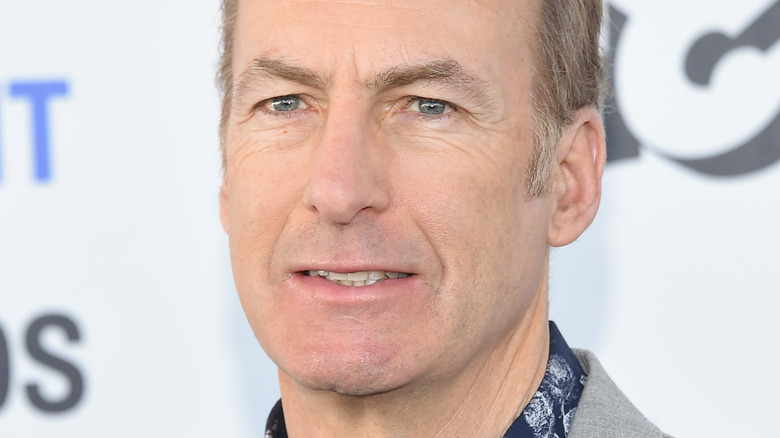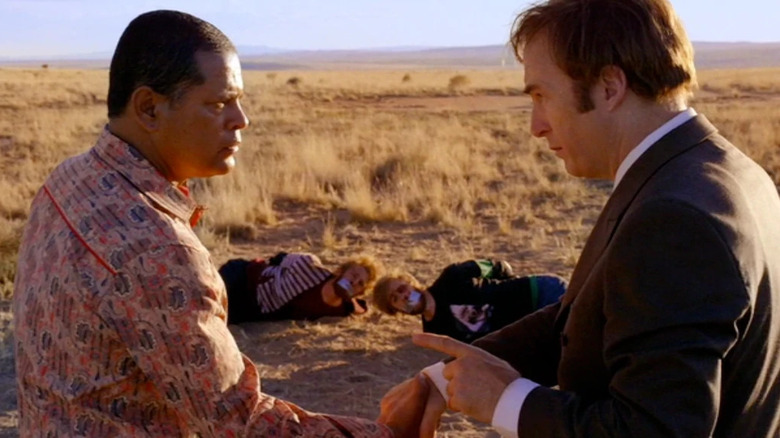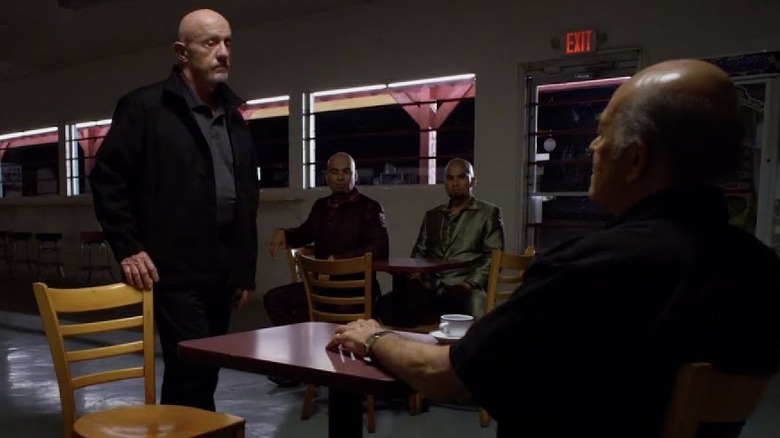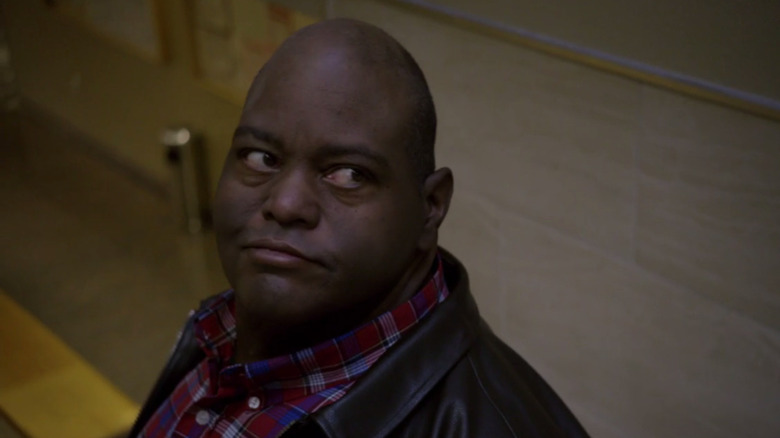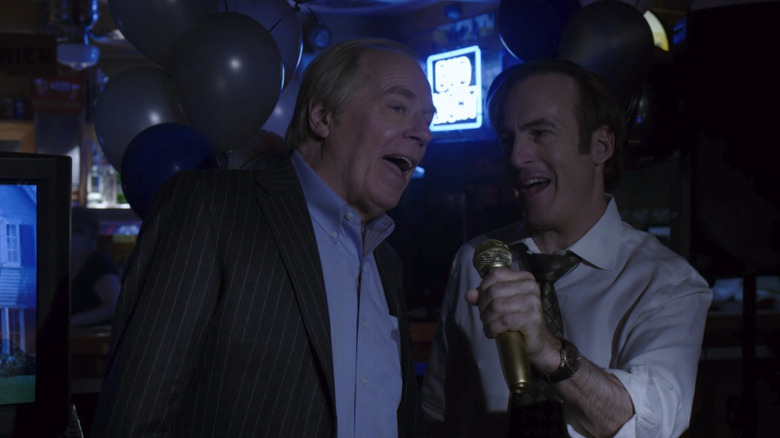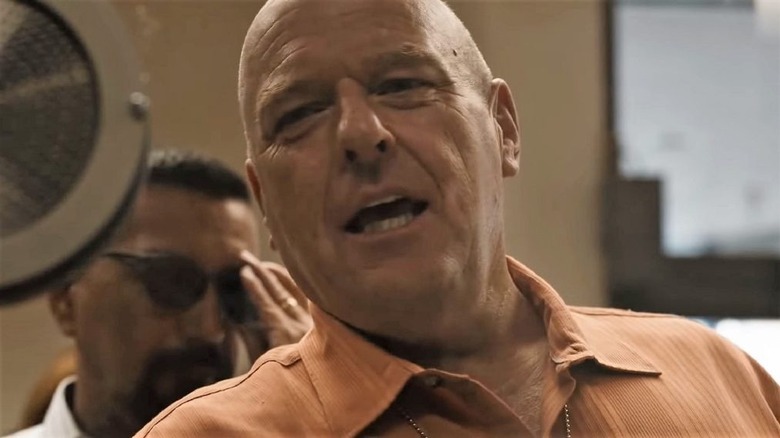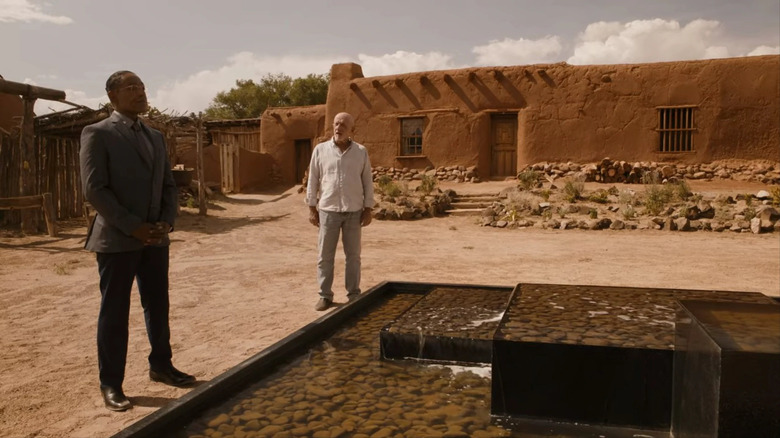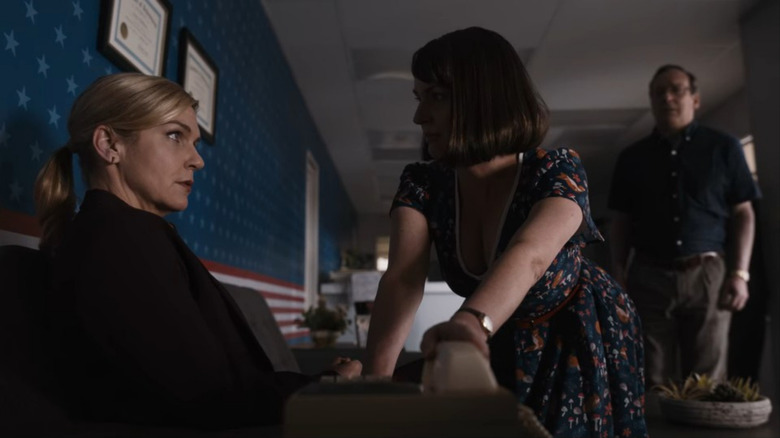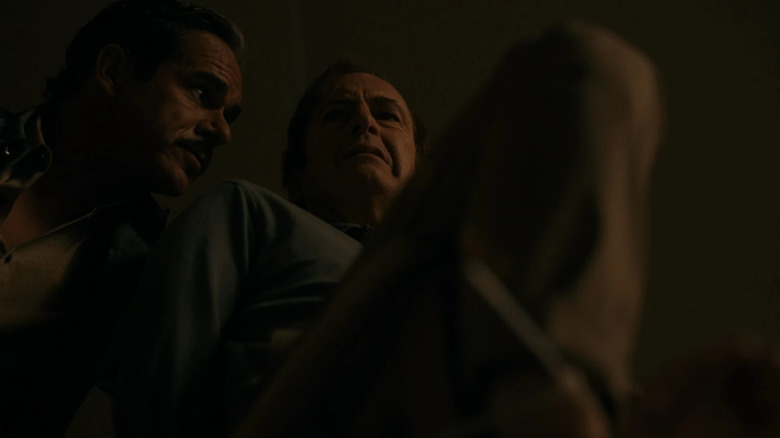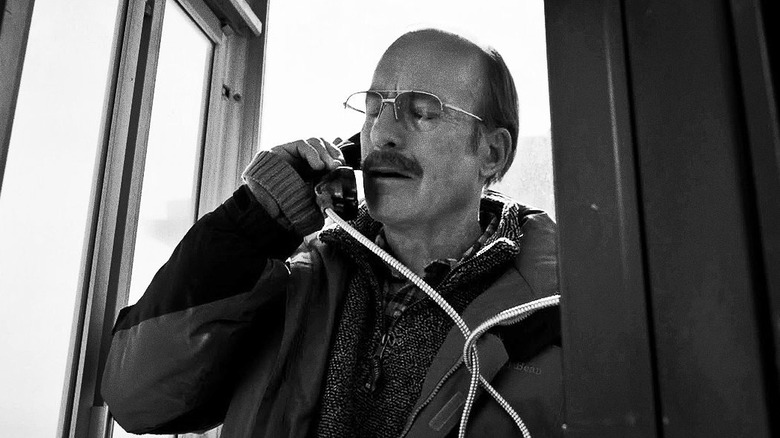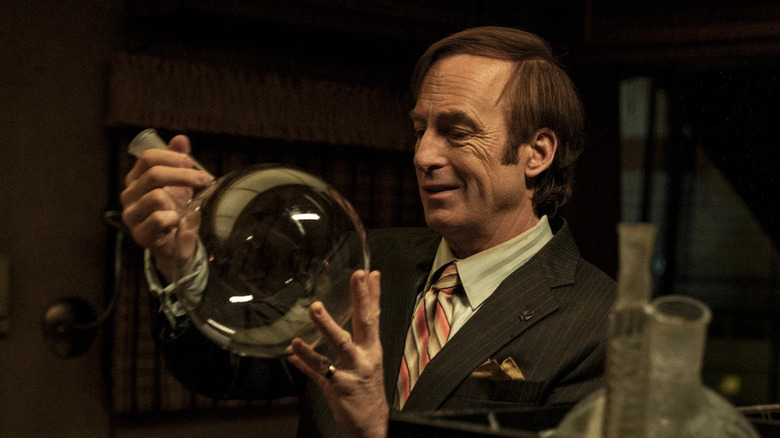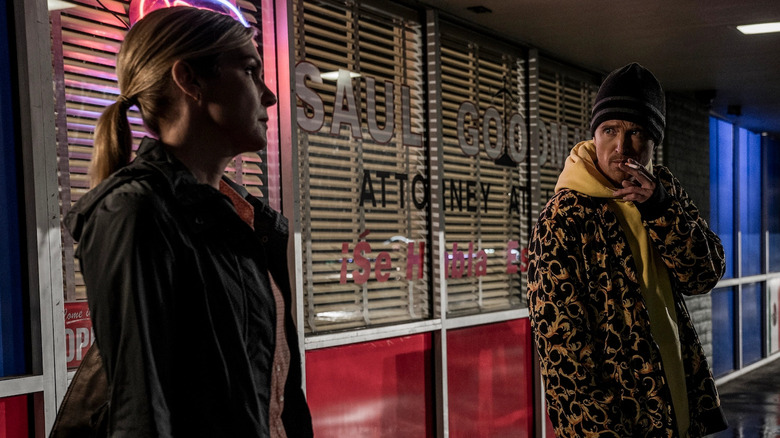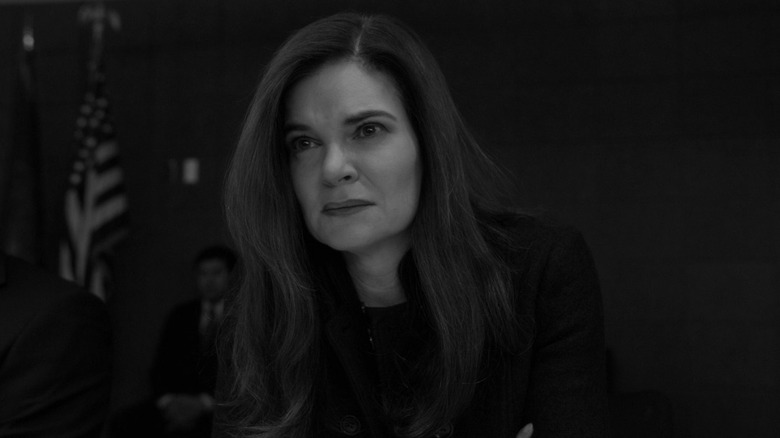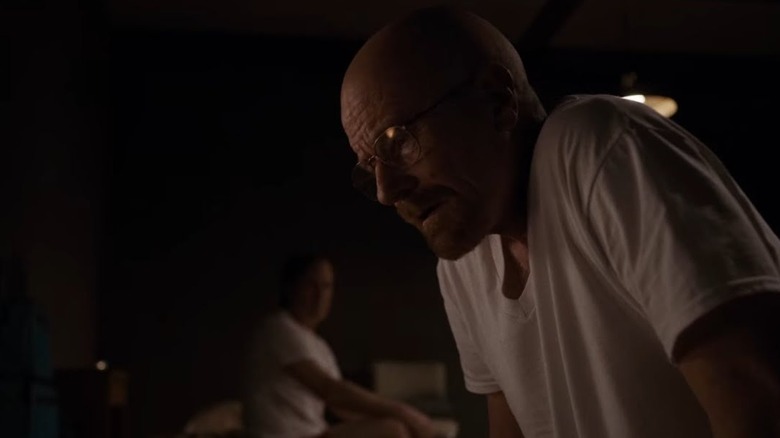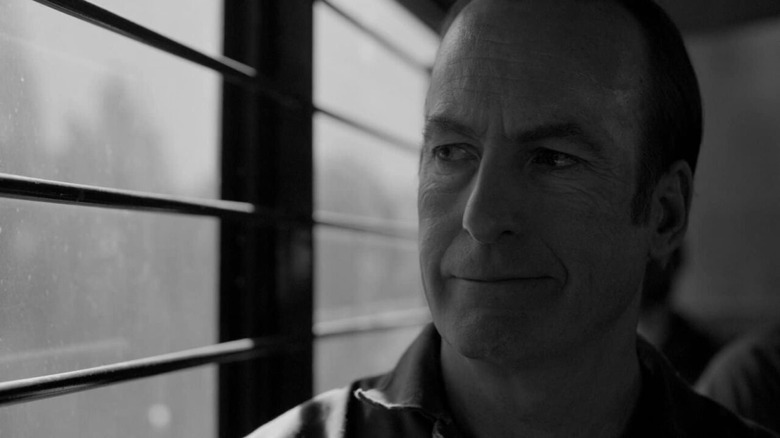Better Call Saul Scenes That Wound Up Being Complete Fan Service
"Better Call Saul" concluded its seven-year run in August 2022, ending 13 years after the premiere of its predecessor, "Breaking Bad." As a prequel series to the original show, "Better Call Saul" not only follows the journeys of brand-new characters, but also slowly crosses paths with characters who eventually become wrapped up in the misadventures of Walter White and Jesse Pinkman. Some moments in "Better Call Saul" even directly foreshadow significant plot points in "Breaking Bad."
Whether it be the introduction of a familiar Albuquerque face or even a moment where new "Better Call Saul" characters get the spotlight, certain moments in the show can be classified as "fan service." These episodes became the subject of plenty of articles and fan discussions about how they deepen the events of "Breaking Bad." It was also extremely exciting for fans to see more glimpses of characters whose stories were short-changed by "Breaking Bad" or who left the series earlier than some fans would've hoped.
"Better Call Saul" also used fan service wisely, not just targeting fans who want to see the "Breaking Bad" cameo of the week. Oftentimes, these appearances were carefully considered and contributed to the character development of its protagonists: Jimmy McGill, Kim Wexler, or Mike Ehrmantraut. Other times, these appearances and moments progress the story as much as anything else, albeit with some well-earned excitement for eager "Breaking Bad" fans.
Jimmy's confrontation with a cartel madman
From the very first episode (fittingly titled "Uno"), "Better Call Saul" shares a lot of DNA with "Breaking Bad." Alongside Saul — who, at this point, is practicing under his real name, Jimmy McGill — viewers get to see former Gus Fring henchman Mike Ehrmantraut working as a parking lot attendant. However, the series makes a big reference to its predecessor in the episode's last moments, when Jimmy finds himself at gunpoint by the notorious meth kingpin Tuco Salamanca.
Years before Tuco's work with Walt and Jesse, as well as his death at the hands of Hank Schrader, Tuco crosses paths with Jimmy after a scam against a prospective client goes wrong. Jimmy ends up in the desert with the two skateboarding twins he conspired with and almost gets killed by Tuco before being saved by the reasoning of Tuco's right-hand man, Nacho. After Jimmy is freed, he negotiates with Tuco to get the twins' sentence reduced from death to a single broken leg each.
While it's fan service-y to introduce a high-stakes "Breaking Bad" character this early, Tuco ends up being important for "Better Call Saul" by introducing the audience to Nacho Varga, who becomes a significant player in the cartel storyline (via The Hollywood Reporter). Tuco even makes another appearance in Season 2, when Mike tricks Tuco into assaulting him in front of the police. This results in Tuco going to prison, where he'd remain until shortly before the events of "Breaking Bad"'s first season.
Mike makes a deal with the Salamancas
As "Better Call Saul" heads into its second season, Mike finds himself in the throes of a conflict with the Salamancas, a powerful family in the Mexican cartel. Mike is hired by Nacho to kill Tuco, but Mike instead gets Tuco thrown in prison for assault with a deadly weapon. However, this scheme draws attention to Mike nonetheless. Hector Salamanca, pre-wheelchair and bell, approaches Mike in a diner and offers to pay him to tell the authorities that the gun was Mike's, not Tuco's.
Mike initially refuses the offer, resulting in Salamanca henchmen being sent to his house to assault him. It's not until Mike's granddaughter is threatened by the iconic Salamanca cousins that he considers taking Hector's offer. This is a pivotal moment in "Better Call Saul," as it introduces Hector and the cousins into the conflicts of the prequel series, which they'll continue to be involved in through the show's final season.
It only makes sense to "Breaking Bad" fans how the introduction of these characters raises the stakes. The "Breaking Bad" audience recognizes the cousins, despite their brutal end thanks to Hank Schrader, as real threats to Walter White's growing empire. The appearance of a non-disabled Hector also promises that audiences will learn what makes him a near-vegetable. It also alludes to the long-anticipated appearance of Gus Fring in future seasons.
Jimmy recruits his future bodyguard
Throughout the early seasons of "Better Call Saul," fans eagerly awaited the eventual appearance of some of Saul Goodman's best cronies. In "Breaking Bad," comedians Lavell Crawford and Bill Burr played Saul's usual henchmen, Huell and Kuby. While Burr's busy schedule never allowed him to reprise his role in "Better Call Saul," Crawford finally re-appeared during the show's third season. Jimmy hires Huell through Dr. Caldera, a veterinarian who acts as a middle-man between petty criminals and professional assassins.
While Huell's appearance is sure to excite "Breaking Bad" fans, it comes at one of the show's highest highs. Jimmy hires Huell to pull off one of his signature slips, bumping into his brother Chuck on a staircase and planting a cell phone battery on him. Jimmy uses this trick as proof to a court that Chuck's electromagnetic hypersensitivity is not a physical illness, but a mental one. Even with only one line in the episode, Huell completely steals the show (albeit not from Michael McKean, who delivers one of the show's best monologues upon learning of the trick).
Thankfully, this moment of fan service is not the last time fans get to see Huell. Crawford continues to appear throughout the rest of "Better Call Saul" as Jimmy's go-to bodyguard and henchman. He becomes especially important to the events of Season 4, after he's arrested and Jimmy enlists Kim to help get his case dismissed.
Jimmy sings karaoke with Chuck
Not every moment of fan service in "Better Call Saul" features the return of a beloved "Breaking Bad" character. In the case of an episode like Season 4's "Winner," the return of a beloved "Better Call Saul" character might be even more emotional for fans. At the end of Season 3, Jimmy's brother Chuck dies by suicide after kicking over a lantern and burning his house down. The majority of Season 4 finds Jimmy reeling from the death of his brother, choosing to neglect his feelings and dive deeper into the criminal persona of Saul Goodman.
The Season 4 finale subverts this journey of Jimmy's neglect of Chuck by flashing back to the moment when Jimmy is accepted by the New Mexico State Bar. Jimmy is joined by his brother and his fellow HHM employees at a karaoke bar, where Jimmy coerces Chuck into joining him on stage to sing "The Winner Takes It All" by ABBA. After a season of having lost Michael McKean as a main cast member of "Better Call Saul," it's heart-wrenching to see him return in a moment that reminds audiences of what Chuck and Jimmy's relationship could've been.
Thankfully, this is also not the final appearance of Chuck. Michael McKean returned again during the show's finale in a flashback that takes place shortly before the first episode of "Better Call Saul."
If you or anyone you know is having suicidal thoughts, please call the National Suicide Prevention Lifeline by dialing 988 or by calling 1-800-273-TALK (8255).
Saul Goodman vs. the DEA
Season 5 finds "Better Call Saul" treading closer to the story of Walter White than it ever has before. After Krazy-8 is arrested, Lalo Salamanca hires Jimmy to act as his lawyer and pass along false information to the DEA. When Jimmy finally shows up to represent Krazy-8, his DEA opponents are the familiar faces of Hank Schrader and Steve Gomez. This is a long overdue return for Dean Norris and Steven Michael Quezada, who were last seen meeting their demise at the hands of neo-Nazis in the climactic "Breaking Bad" episode "Ozymandias."
Seeing Hank and Gomez banter as they enter the police station to interview Krazy-8 is one of the most exciting moments of Season 5. It may also feel quite nostalgic for "Breaking Bad" fans to see Hank meet Saul Goodman for the first time, preluding their various interactions throughout "Breaking Bad." The two even make an additional cameo in the subsequent episode, following through on Lalo's provided information. It's only a shame they don't appear again after this.
Gus pays tribute to his former partner
"Better Call Saul" brings Gus Fring back during the third season, giving Giancarlo Esposito four seasons to flesh out his "Breaking Bad" antagonist. Previously, little was known about Fring's backstory in "Breaking Bad," up until a flashback in Season 4 wherein Hector kills Gus' business partner, Max Arciniega, fueling his desire for revenge in the present. At the time, fans had speculated that Gus' relationship with Max was more romantic than the show implied.
Luckily, those fans were proven right as "Better Call Saul" explored Gus' character. In the Season 5 episode "Dedicado a Max," Mike and Gus have a conversation on a Mexican compound where Mike is recovering from injuries he sustained during an alcoholic bender. As Gus tells Mike they share a similar need for revenge, the audience gets a look at the memorial fountain they're standing in front of, with the episode's title etched on its side. Clearly, the writers listened to fans' speculations, and Max meant more to Gus than initially thought.
Gus' sexuality is even more explicitly referenced in the Season 6 episode "Fun and Games," during a scene where Gus flirts with a sommelier. It's quite a good use of fan service to take a fan theory and use it to fuel character development in the prequel series.
Jimmy and Kim surprise the Kettlemans with a new scheme
The first season of "Better Call Saul" features highly incompetent white-collar criminals Betsy and Craig Kettleman. Craig's embezzlement of government funds lands them in hot water and leads them to become clients for Saul Goodman's burgeoning law career. They eventually go with HHM, bribing Jimmy to keep quiet about the money, though the upstart lawyer eventually hires Mike to steal their money and turn it in to the district attorney. They eventually settle for a deal with Kim Wexler that puts Craig in prison for 16 months.
Season 6 of "Better Call Saul" brings the Kettlemans back into the fray for one more scheme crafted by Jimmy and Kim. As part of their plan to ruin Howard Hamlin's reputation, Jimmy convinces the couple that Howard's rumored cocaine addiction could result in Craig's exoneration. The couple, just as Jimmy and Kim intended, visit several Albuquerque law firms spreading the information, most importantly to Clifford Main.
When Betsy and Craig discover the con, they threaten to turn Jimmy and Kim in. Fortunately, Kim's turn to the dark side means she can fight fire with fire, threatening to turn the Kettlemans in themselves for tax fraud. Despite how harrowing it is to see Kim stoop so low, "Better Call Saul" fans will get quite a kick out of seeing the naive Kettlemans get their just deserts one more time before the series makes its final curtain call.
Lalo makes a promise to Jimmy
By far, the biggest turning point in six seasons of "Better Call Saul" comes when Lalo Salamanca shows up at Kim and Jimmy's apartment and murders Howard Hamlin. Not only does it feature the inevitable crossing of paths between the lawyer storyline and the cartel world, but it's an irreversible consequence of Jimmy and Kim's actions. Unfortunately, the ride isn't over yet, as Lalo has business to take care of and needs his lawyers' help.
This leads the audience to Episode 8 of Season 6, "Point and Shoot," which opens with Lalo explaining his plan to a horrified Kim and Jimmy. One of them will drive to Gus Fring's house, politely knock on the door, and open fire, while the other stays in the apartment with Lalo. Jimmy, thinking on his feet, convinces Lalo to send Kim, getting her out of the apartment and away from Lalo. As Jimmy explains that the assassination attempt on him was Nacho's doing, Lalo ties him up and promises he'll be back.
While this may seem like a regular, high-stakes moment in "Better Call Saul," it actually lays the groundwork for Saul's introduction into the world of Walter White. Back in "Breaking Bad," Walt and Jesse kidnapped Saul in the desert, where Saul repeated, "It wasn't me, it was Ignacio!" This easter egg confirms that, even in the days of "Breaking Bad," Saul is still haunted by the threat of Lalo returning (via Entertainment Weekly).
Gene gets an update from Albuquerque
It was always in the cards that "Better Call Saul" would eventually crossover with "Breaking Bad" and end in the post-Walter White story of Gene the Cinnabon manager. That plan finally comes to fruition in the 11th episode of Season 6, appropriately titled "Breaking Bad." In Omaha, Gene makes a phone call to his old secretary Francesca, asking for updates on the state of Albuquerque in the wake of Walter White's crumbled empire.
Many "Breaking Bad" fans will be pleased to hear this conversation, which provides some long-overdue updates on the world of Albuquerque after "Breaking Bad." For starters, all of Saul Goodman's assets have been seized, from nail salons to shell corporations. Francesca's still being followed by the government, and the cops are still looking for Saul Goodman. She also tells him that Bill Oakley became a defense attorney (a detail that will be important for later) and that Kim called asking about Jimmy.
This phone call also ties up some loose ends for eager "Breaking Bad" fans. Huell finally left the safe house and returned to Louisiana, while Saul's other cronies like Kuby, Ira, and Danny (confirmed to be Pryce from the early seasons of "Better Call Saul") are nowhere to be found. Skyler White gets her deal with the police, and Jesse is presumed to have escaped to Mexico after his car was found near the border (calling back to Skinny Pete's plan in "El Camino.")
Saul seizes a business opportunity
Fan service or not, it wouldn't have felt right for "Better Call Saul" to end without getting one last appearance from Bryan Cranston and Aaron Paul as Saul's biggest clients, Walter White and Jesse Pinkman. It's even more fitting that this finally occurred in the Season 6 episode, "Breaking Bad." Midway through the episode, the show flashes back to shortly after Saul's fateful meeting in the desert with Walter and Jesse. Not only is this a delightful scene between three "Breaking Bad" veterans, but it's also the first time the audience has seen Saul in the iconic RV.
The opportunity to show Saul inspecting Walt and Jesse's meth operation allows for some quality Walt and Jesse banter, but also carries importance going forward. Through flashbacks to the "Breaking Bad" timeline, this episode shows how complicit Saul was in turning Walter White from an amateur meth cook into a kingpin. This is shown even more in a later scene where Saul meets with Mike, who advises against working with the inexperienced Heisenberg.
An additional moment in this RV scene that may delight "Better Call Saul" fans is Jesse's inquiry about who Lalo is. Saul brushes the question off, claiming Lalo is nobody, which is a callback to Lalo saying the same thing when Howard first questions who he is in "Plan and Execution." Leave it to the "Better Call Saul" writers to not let an opportunity for fan service go to waste.
Kim crosses paths with a young Jesse
Even Vince Gilligan can't help but deliver quality fan service. His final work in the "Breaking Bad" universe (for now) comes in the penultimate episode of "Better Call Saul" titled "Waterworks." The episode spends most of its time focusing on Kim Wexler's life following the events of "Breaking Bad," living a mundane existence in Florida working for a sprinkler company. Despite the dreariness, it's a tour-de-force performance from Rhea Seehorn as Kim grapples with guilt and regret.
It also features one of the most exciting crossovers with "Breaking Bad." In a scene taking place shortly before "Breaking Bad," Kim visits Saul Goodman's offices to sign divorce papers. Saul emotionally stonewalls Kim, telling her to have a nice life in Florida as she stares down a man she once loved (and maybe still does). When she walks outside for a smoke in the rain, she's approached by none other than Jesse Pinkman, who bums a cigarette off her.
Though Gilligan has admitted the scene isn't wholly necessary (via Variety), it's hard to not smile seeing these two lovable characters interact, even if briefly. Jesse even recognizes Kim as Combo's former attorney and asks for her legal expertise on whether Saul Goodman is a good lawyer or not. Kim's reply that he was when she knew him is not only one of the most haunting lines in all of "Better Call Saul" but also has powerful implications for the rest of "Breaking Bad."
Saul faces a victim of his crimes
The finale of "Better Call Saul" is a master class in delivering a satisfying, fitting conclusion to a story. It even satisfies expectations of "Breaking Bad" fans who want one more big cameo, which comes in the form of Betsy Brandt as Marie Schrader. After Saul is arrested and faces 190 years plus a life sentence for his various crimes with Walter White, he is brought into a meeting to arrange a plea deal with the prosecution.
That's where Marie comes in to force Saul to face a victim of his actions. She tells him that no punishment will be justice for what he's done, prompting Saul to do what he does best: lie. Saul spins a tale of living in fear of Walter White ever since that day in the desert, only revealing the con when the prosecutors laugh in his face that a jury would never buy it. Saul smiles, reminding them he only needs to convince one.
While it's a chilling reminder of how callous and cunning Saul can be to get what he wants, it's also a nice slice of fan service to see Marie again. The character's grief is overlooked throughout the final episodes of "Breaking Bad," and this powerful albeit brief appearance does her justice (via The AV Club).
Saul is kept up by Walter White
The finale of "Better Call Saul" also features a curtain call for Bryan Cranston's iconic role of Walter White. After the brief RV scene in "Breaking Bad," Walt appears in another flashback in "Saul Gone," this time taking place while Saul and Walt are sharing a room together in Ed Galbraith's basement during the events of "Granite State," the penultimate episode of "Breaking Bad." In the original scene, Walt tries to intimidate Saul into finishing the job they've started, but Saul half-heartedly tells Walt that "it's over," before leaving for his new life in Nebraska.
This scene, however, reminds audiences of a much different power dynamic between the two. As Walt keeps Saul up by trying to fix a water heater, Saul inquires about what Walt would do with a time machine (a conversation he shares throughout the episode with Mike Ehrmantraut and Chuck McGill). Walt belittles Saul's question but eventually plays along with Saul's deeper query about regrets. When Saul recounts his biggest regret as injuring his knee during a slip-and-fall, Walt casually remarks, "So you were always like this."
While it's nice to see Walter White one last time, this scene is more than just fan service. It recontextualizes the audience's perception of Walt as less of an action anti-hero, but a pathetic, neurotic man who puts others down to satisfy his own ego.
Jimmy heads to prison
When Saul Goodman finally shows up at court, he does something unthinkable: he confesses. In front of the prosecution, Oakley, Marie, and especially Kim Wexler, Saul completely owns up to his role in turning Walter White from a chemistry teacher in over his head into the most dangerous drug manufacturer in the United States. More importantly, he confesses his role in Chuck's suicide and Howard's murder, before finally reaffirming his identity as Jimmy McGill.
Suffice it to say that Saul Goodman's 7-year plea deal is thrown out the window and Jimmy McGill faces 86 years in federal prison. A scene towards the end of the finale shows Jimmy sitting on a bus full of prisoners. When one of them recognizes him as Saul Goodman, all the prisoners begin chanting "Better Call Saul!" as the guards tell them to quiet. A grim smile crosses Jimmy's face.
While this scene arguably establishes that Jimmy's future in prison isn't completely bleak (via ScreenRant), it's quite a bit of fan service to see a bus full of prisoners chanting the title of the series. In all fairness, it's a well-earned moment, and probably similar to how audiences reacted to the show's ending.
